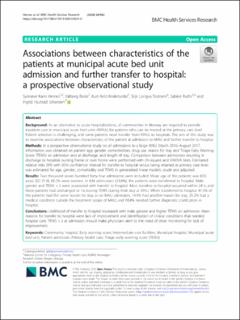| dc.description.abstract | Background
As an alternative to acute hospitalisations, all communities in Norway are required to provide inpatient care in municipal acute bed units (MAUs) for patients who can be treated at the primary care level. Patient selection is challenging, and some patients need transfer from MAUs to hospitals. The aim of this study was to examine associations between characteristics of the patient at admission to MAU and further transfer to hospital.
Methods
In a prospective observational study on all admissions to a large MAU, March 2016–August 2017, information was obtained on patient age, gender, comorbidities, drug use, reason for stay and Triage Early Warning Score (TEWS) on admission and at discharge, and length of stay. Comparison between admissions resulting in discharge to hospital, nursing home or own home were performed with chi-square and ANOVA tests. Estimated relative risks (RR) with 95% confidence interval for transfer to hospital versus being retained at primary care level was estimated for age, gender, comorbidity and TEWS in generalized linear models, crude and adjusted.
Results
Two thousand seven hundred forty-four admissions were included. Mean age of the patients was 69.5 years (SD 21.9), 65.2% were women. In 646 admissions (23.6%), the patients were transferred to hospital. Male gender and TEWS > 2 were associated with transfer to hospital. Most transfers to hospital occurred within 24 h, and these patients had unchanged or increasing TEWS during their stay at MAU. When transferred to hospital 41.5% of the patients had the same reason for stay as on MAU admission, 14.9% had another reason for stay, 25.2% had a medical condition outside the treatment scope of MAU, and 18.4% needed further diagnostic clarification in hospital.
Conclusions
Likelihood of transfer to hospital increased with male gender and higher TEWS on admission. Main reasons for transfer to hospital were lack of improvement and identification of clinical conditions that needed hospital care. TEWS > 2 at admission should make physicians alert to the need of close monitoring for lack of improvement. | en_US |
